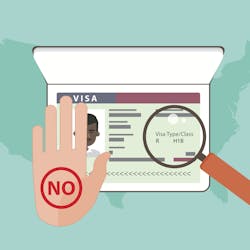Almost 20 years ago, I remember reading a column from Electronic Design’s then editor-in-chief talking about the controversy surrounding H-1B visas and their potential impact on EEs in the United States. As the saying goes, “The more things change, the more they stay the same,” as I now sit writing this column for you.
Since the late 1990s, the controversy surrounding H-1B has at times gone quiet, but never completely died. In the engineering world, the fact is that importing talent has allowed many companies to stay competitive by hiring highly skilled and specialized engineers who were not available in the United States or not in the needed numbers. The other side of the argument points to a chicken-and-egg scenario: By not hiring U.S. engineers because they lacked certain skills or knowledge, we failed to pressure our schools and universities to “raise the bar,” so to speak, thus creating a door that had to be continuously propped open. We’re now in a moment in history where our current president has made unemployed workers a core focus, which has put H-1B again under fire.
To be clear, there are many fine websites and publications covering the political realm of this nation and others—and many not so fine. But our job is to cover the technology, trends, and developments in electronics engineering from our own independent—but technology- and engineering-focused—standpoint. In particular, my goal with this column is to provide an overview of what the president’s intentions and plans seem to be with H-1B Visas and what impact they may have.
For anyone who doesn’t know, an H-1B is a three-year visa that specifically targets workers in science, engineering, and information technology (IT). It requires the hiring company to have a need for specialized expertise and knowledge, which ideally should limit them from hiring an outside resource just to pay a lower wage. Yet it can be hard to prove that, as noted in an article from Business Insider: “Companies are required under federal regulations to declare that the H-1B workers they employ are not displacing American workers, but a loophole exempts them from that rule if the guest workers they employ are paid at least $60,000 per year. Since American tech workers usually earn higher salaries than $60,000, companies are able to hire foreign workers at lower salaries than American ones, and need not prove they are not undercutting American labor.”
Issues like that loophole will not be resolved any time soon, as the presidential order is only calling for fact-finding at this stage. “In order to promote the proper functioning of the H-1B visa program, the Secretary of State, the Attorney General, the Secretary of Labor, and the Secretary of Homeland Security shall, as soon as practicable, suggest reforms to help ensure that H-1B visas are awarded to the most-skilled or highest-paid petition beneficiaries,” states the “Presidential Executive Order on Buy American and Hire American.”
Looking at the scope of the project, the vast number of visas that are awarded, and the different industries involved, this process will certainly be lengthy and complicated. As a result, it should have no near-term impact on Silicon Valley and high-tech companies in other parts of the country, which largely rely on outsourced engineering and technology expertise. The key is to revamp the program with enough oversight to end abuse of the salary loophole while spurring innovation and the employment of tech workers in America. Our ability to innovate must be safeguarded—but not at the expense of our workers.
Feel free to send comments to [email protected].

